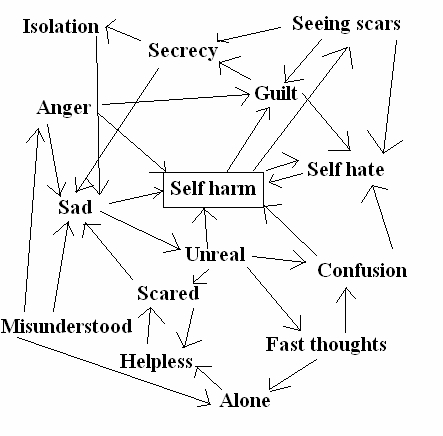Understanding Self-harm and Caring for those who Self-Harm

Self-harming is usually a way of expressing deep emotional pain that they don't have the full capacity to express, explore and process. The emotional pain may come from a single incident, ongoing or unaddressed early trauma, a recognition of dysfunction in the family, coming to terms with one's own identity or any other such factor.
Self-harm and Self-injury need not necessarily mean the person is suicidal, but it does need professional attention at the earliest to help them understand how they can care for themselves without resorting to harmful actions.
It is *NOT* a fad or just something teenagers do "these days," and needs understanding and attention.
Self-harm and Self-injury need not necessarily mean the person is suicidal, but it does need professional attention at the earliest to help them understand how they can care for themselves without resorting to harmful actions.
It is *NOT* a fad or just something teenagers do "these days," and needs understanding and attention.
How do you recognize self-harm?In children and young adults, self-harming behaviour usually starts off as a secretive or private behaviour, which leads to other actions that seek to cover up this behaviour. Other groups that are vulnerable are adults who are in some way deprived of autonomy and social freedom. This could be as varied as highly-educated people who suddenly find themselves in a foreign country on dependent visas, to retirees who find themselves out of place in their own homes, to mid-career professionals dealing with a drastic change in professional circumstances.
This can include changes in clothing, hair styles, keeping hands in pockets all the time, avoiding group time etc. An attentive adult can pick up on these changes. Sometimes, there are also mental illnesses that are there alongside which need attention, especially clinical depression. For many, self-harm may be episodic and closely related to a particular emotional distressing situation. |
Why does anyone even start self-harming?The first experiences with self-harming is often without much of a conscious process or decision - an almost accidental discovery that inflicting physical pain on oneself somehow seems to give a sense of relief or temporary de-focussing from an ongoing deep emotional suffering. For a few, finding that other people who are suffering like them harming themselves for relief might lead them to trying for themselves as well.
In time, one learns to use it as a way of giving themselves a way out or a reprieve from ongoing emotional distress, and if the situation doesn't change or they don't discover a different way of coping, the self-harming behaviour can become more set, more deliberate and habitual. For a few, the self-harming can recur again even after the original situation is resolved when a new trigger occurs - in new situations where again their ability to cope gets challenged, or a personal experience, or reading/ witnessing others' experiences that remind them of their own deep pain or a fear that they might again be in that deep hole, and they might self-harm as a quick way of release. Hopefully, if they have addressed their earlier self-harm, any new cycles will be shorter. Recovery comes with insight that they don't want to self-harm and they seek out help earlier, learn a lot more emotional resilience and healthier coping. Self-harm can stop altogether. |
How can families, schools & organisations help |
At the outset, you can let them know that you have become aware of this behaviour, your concern and your availability to discuss things if they want to, but please do not insist that they disclose. You can help by remaining calm and patient, much more than becoming anxious or panicking. Ther person might not trust you or want to open up with you - please don't make it your mission to change things, and if the person is not willing to discuss with you, please don't take it as a personal disappointment or get frustrated. You can certainly insist that they seek assistance, and if it is a child self-harming, please do alert the immediate family or caregivers you feel can be trusted, for possible counselling and mental health intervention.
If and when they do begin to express, you can help by asking simple questions to try and understand. Gently look to help them find other resources for themselves, and to identify positive qualities about life and themselves. Try and maintain a non-judgmental attitude, and try to take an attitude that nothing is too shocking for you. You need not agree with them or feel the same way, but you can express that you understand how they might feel. A key benchmark is to see who is speaking more - if you feel you are speaking more, slow down. It is OK to be silent together. Even if they are not talking, just being with them in comfortable silence can be great for the child. Above all, your discretion, watchfulness, patience and availability matter. As people learn more effective communication and coping tools, self-harming behaviour does tend to go away. The DON'Ts and DOs : What can you do to help |
|
What you may not want to do are the following:
1. Don't make a hue and cry about it. Don't make it public. Certainly keep it confidential from other peers. 2. Don't demand that they stop the practice, or threaten with adverse consequences 3. Don't probe, and don't assume highly traumatic events. Don't ask for any details on possible family issues, especially if you know of any dysfunction 4. Don't lecture them on how they should cope with life challenges, what is good for them or how they need to grow up 5. Don't make them feel guilty or shamed. Do not tell them they are hurting you, their family or organization by this behaviour Please do not try and please the person or promise things so that they don't hurt herself, as that might lead to manipulative behaviour. Also, look out if small cliques are getting formed with other similar people, and gently reduce grouping possibilities, or create a formal support group with an experienced therapist. What you can do to help: 1. Keeping a watchful eye over them, reducing alone time 2. Helping them engage with other activities (without making a project of it) 3. Staying open and available when they choose to try and express 4. Keeping the environment as predictable and friendly as possible |
A few quick FAQs on self-harm
1. Are people self-harming for pleasure? Is it BDSM?
BDSM is a nuanced experiencing of sexuality where practitioners willingly explore and experience sensations between pain and pleasure as part of their sexual activities, with there being clear safety and control protocols. It has little to do with self harm at all. A simple distinction is that BDSM is about pleasure and enjoyment while self harm is not.
2. Is this a western fad? Are Indian teenagers learning by watching/ reading things on Internet
No, this is *NOT* a fad. Mental health concerns of young adults are very real concerns and one cannot wish them away. There is always the possibility that people, of any age, are learning different ways of coping including unhelpful ways through the popular culture available for them - even then, the underlying issues and concerns are very real and needs to be addressed.
3. Is self-harm a teenage issue?
It is a myth that self-harm is a teen and/or girl issue. Self-harming does not discriminate by age or gender.
Pre-teens and young adults who are going through some psycho-social stress that is leaving them vulnerable are most susceptible to self-harming as a way of coping with situations that they find overwhelming in some way.
Other groups that are vulnerable are adults who are in some way deprived of autonomy and social freedom: This could be as varied as highly-educated people who suddenly find themselves in a foreign country on dependent visas, to retirees who find themselves out of place in their own homes, to mid-career professionals dealing with a drastic change in professional circumstances.
Self-harm behaviours may vary by age/ gender, with some activities like cutting more common among younger people, burning/ hair-pulling among older people, and hitting/ banging among others.
Pre-teens and young adults who are going through some psycho-social stress that is leaving them vulnerable are most susceptible to self-harming as a way of coping with situations that they find overwhelming in some way.
Other groups that are vulnerable are adults who are in some way deprived of autonomy and social freedom: This could be as varied as highly-educated people who suddenly find themselves in a foreign country on dependent visas, to retirees who find themselves out of place in their own homes, to mid-career professionals dealing with a drastic change in professional circumstances.
Self-harm behaviours may vary by age/ gender, with some activities like cutting more common among younger people, burning/ hair-pulling among older people, and hitting/ banging among others.
4. Is self harm triggered by an incident or a consequence of mental illness
Self-harming is usually a way of expressing deep emotional pain that they don't have the full capacity to express, explore and process. The emotional pain may come from a single incident, ongoing or unaddressed early trauma, a recognition of dysfunction in the family, coming to terms with one's own identity or any other such factor. For many, self-harm may be episodic and closely related to a particular emotional distressing situation.
Sometimes, there are also mental illnesses that are there alongside which need attention, especially clinical depression. It always helps to consult a mental health professional in either case.
Sometimes, there are also mental illnesses that are there alongside which need attention, especially clinical depression. It always helps to consult a mental health professional in either case.
5. Why do people harm themselves so secretively? Are they ashamed of it?
When people harm themselves, there are often elements of guilt and shame in the cycles of self-harming and emotinal distress, which keep them in that loop till something changes to help get out of that loop. Quite often, self-harming is a private, discreet and secretive activity, because one knows that it won't be welcomed - there may not be 'shame' in self-harm itself- just the idea that people won't understand, judge and make things worse that they already feel, the idea that they are going to be judged, misunderstood, lectured to, controlled or manipulated makes people not want to share, even after they have stopped, and we need to respect that.
For people who used to self-harm but have since stopped, and grown from it, some may choose to be open with their scars and invite conversations to help more people understand and talk about mental health. Most would, reasonably, stay private and really disclose only to those who they trust and with whom they feel safe.
For people who used to self-harm but have since stopped, and grown from it, some may choose to be open with their scars and invite conversations to help more people understand and talk about mental health. Most would, reasonably, stay private and really disclose only to those who they trust and with whom they feel safe.
6. Isn't Self-Harming just attention-seeking behaviour?
The truth is that people who self-harm usually harm themselves in secret and do not really want to draw any attention to it at all.
In reality, the fear of being shamed about it and being judged keeps them from talking about it at all. When they do disclose about self-harming, it is to ask for help as they realize they need to take care of themselves.
In reality, the fear of being shamed about it and being judged keeps them from talking about it at all. When they do disclose about self-harming, it is to ask for help as they realize they need to take care of themselves.
7. Are online resources useful? What if they trigger new self-harm cycles?
Given that self-harm can be isolating, it can really help to reach out online for support as it provides some anonymity and safety, and so people do actively seek out online support and resources. That said, certainly there is a risk that other people's suffering triggers one's own negative thought cycles, memories and increases suffering.
The key then is to use online resources that are moderated, backed by professionals, and of course, that online resources are used as a supplement to in-person support, not as a substitute.
The key then is to use online resources that are moderated, backed by professionals, and of course, that online resources are used as a supplement to in-person support, not as a substitute.
8. What kind of behaviours constitute self-harm?
While cutting is what we most commonly see as self-harm, there are many other behaviours: pinching/ scratching oneself, banging/ hitting oneself on or with objects, biting/ slapping oneself, poisoning, using knives to carve symbols/ words, picking off or pulling one's hair in one's body or head, burning deliberately over open flames or with hot objects such as ladles, substance abuse, purging, eating chillies or other painful substances, allowing for sexual acts that one is not really ready for... the list can go on.
Any activity that is essentially hurting to one's self, physically, mentally or otherwise is self-harm. Depending on the nature and intensity, one might call it self-injury, self-abuse or self-mutilation.
Any activity that is essentially hurting to one's self, physically, mentally or otherwise is self-harm. Depending on the nature and intensity, one might call it self-injury, self-abuse or self-mutilation.
When do you seek help?If you find that you have been self-harming or having thoughts about self-harming, please call right away. If you find that your child or someone you are caring for may be self-harming, and you are not sure how to address it or to help them, please call right away.
|
More Information1. Self-Harm UK
2. Resources for Parents of people who self-harm 3. The Butterfly Project - An online resource 4. WebMD's moderated discussion board on self-harm 5. Adult self-injury: information and support |

